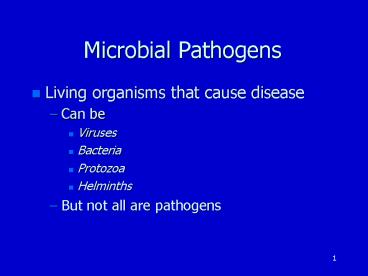Microbial Pathogens - PowerPoint PPT Presentation
1 / 29
Title:
Microbial Pathogens
Description:
need host cells to replicate. infection usually person-to-person, not through water ... Pathogenic Bacteria Photo Gallery. www.geocities.com/CapeCanaveral/3504 ... – PowerPoint PPT presentation
Number of Views:319
Avg rating:3.0/5.0
Title: Microbial Pathogens
1
Microbial Pathogens
- Living organisms that cause disease
- Can be
- Viruses
- Bacteria
- Protozoa
- Helminths
- But not all are pathogens
2
Viruses
- Intracellular parasites
- very small (20-100 nm), very simple
- not composed of cells
- need host cells to replicate
- infection usually person-to-person, not through
water - hepatitis, gastroenteritis....
3
Aside - Units
- nm
- Nano 1/1,000,000,000
- 3 to 6 atoms end to end constitute a nanometer
4
(No Transcript)
5
Detection of Viruses
- Not recommended for routine analyses
- Should be done only by competent and specially
trained water virologists - Three Steps
- Collect representative sample
- Concentrate viruses in sample
- Identify and quantify
- Beyond our capability
6
Problems, Virus Methods
- Very small (20 to 100 nm)
- Generally present at low concentration, but
variable in amount and type - Unstable as biological entities
- Other compounds interfere
- Current methods are limited
7
Bacteria
- microscopic, single-celled organisms
- 500-5000 nm
- procaryotic (DNA not enclosed in membrane)
- most are not pathogens
- perform valuable functions in environment, our
bodies, wastewater treatment - Proliferate in
- feces 1 - 1000 X 106 / gram
- wastewater 10,000 / ml
- Pathogenic bacteria cause typhoid, cholera....
8
Vibrio cholerae (Microbe causing cholera) From
www.bact.wisc.edu/microtextbook/TOC.html
9
Detection Methods - Specific Species
- Not recommended for routine analyses
- Three Steps
- Collect representative sample
- Concentrate bacteria in sample / Grow bacteria
colonies - Identify and quantify
- Stains, size, shape, growth patters, what they
grow on... - Beyond our capability
10
Protozoa
- Microscopic, single-celled "animals", more
complex and larger than bacteria - 10000-15000 nm
- eucaryotic (DNA in nucleus within cell)
- Most not pathogenic
- Form Cysts / Oocysts
- Resistant forms which allows Protozoa to survive
under adverse conditions - Pathogenic protozoans cause diarrhea
(Cryptosporidium), dysentery, gastrointestinal
infection (Giardia lamblia)...
11
Giardia lamblia
- 111 waterborne outbreaks between 1965 and 1990,
gt26,000 cases - Causes diarrhea
12
Cryptosporidium parvum
- Of increasing concern
- Causes cholera-like diarrhea
- can be life-threatening to immunodeficient persons
1993, Milwaukee - 400,000 sick - 50 dead
13
Entamoeba histolytica
- Causes amebic dysentery
- Averages 28 deaths / year
- Has not been a frequent cause of waterborne
outbreaks in recent times
14
Protozoa Detection
- Not recommended for routine analyses
- Crypto and Giardia
- concentrate, purify and distribute organisms in
monolayer on membrane filter - label with fluorescent antibody reagents
- identify cysts and oocysts by specific criteria
(immunoflorescence, size, shape, internal
morphological characteristics) - Beyond our capability
15
Helminths (worms)
- Humans can ingest worm eggs in contaminated water
- Worm can grow inside body, causing disease
- Some (e.g., Hookworms) can infect by penetrating
skin - Worms can cause joint arthritis, damage lymph
nodes, damage tissue and organs - Not of Concern in US
16
Intestinal nematodes - from www.life.sci.qut.edu.a
u/LIFESCI/darben/paramast.htm
17
Drinking Water Standards Pathogens
- Maximum Contaminant Level Goal
- zero pathogens
- Maximum Contaminant Level
- We will accept a limited number of positive
samples (indicator organism) - to account for inadvertent contamination
- re-check water
18
Indicator organisms
- Too difficult to identify all pathogens, so we
use indicator organisms - May not be pathogens themselves
- Find indicator organisms?
- sample might be pathogen contaminated
- Don't find indicator organisms?
- very unlikely sample is contaminated
19
Common Indicator Organisms
- Total Coliform
- Fecal Coliform
- E. Coli
- Common denominator is fecal coliform
- found in intestines
- evidence of fecal contamination
Bacteria
20
General Types of Tests
- Prescriptive tests
- Positive result good indication of presence of
indicator organism, but not definitive - Confirmatory
- Positive result indicates definite presence of
indicator organism
21
Specific Tests
- Membrane Filtration
- Presence/Absence
- Fermentation tube
- (confirmatory)
22
Membrane Filtration
- Filter known volume through sterile filter
- with proper dilution, deposit isolated bacteria
- Place filter in petri dish w/ sterile agar
- promotes organism of interest, inhibits others
- Incubate (time / temperature)
- isolated bacteria grow into easily identified
colonies - Count colonies
- Concentration Colonies / Volume of sample
23
(No Transcript)
24
Presence/Absence
- Add 100 mL sample to broth
- Incubate (time / temperature)
- yellow color indicates presence of coliforms
- Determines presence or absence only
25
(No Transcript)
26
Fermentation Tubes
- (1) Presence/Absence
- Inoculate tube containing special broth
- Incubate (time / temperature)
- gas production in tubes indicates presence
27
Fermentation Tubes
- (2) Concentration
- Inoculate series of tubes with various amounts of
sample - of bacteria introduced proportional to sample
amount - Incubate
- Observe which tubes generate gas
- Statistically relate to most likely concentration
28
(No Transcript)
29
WWW Resources
- EPA Pathogen Document
- www.epa.gov/enviro/html/icr/gloss_path.html
- Germ Tutorial
- www.mwra.state.ma.us/germs/intro.htm
- Pathogenic Bacteria Photo Gallery
- www.geocities.com/CapeCanaveral/3504/
- Cryptosporidium Newsletter
- www.fspubl.com/index.html
- Online Microbiology Textbook
- www.bact.wisc.edu/microtextbook/TOC.html































